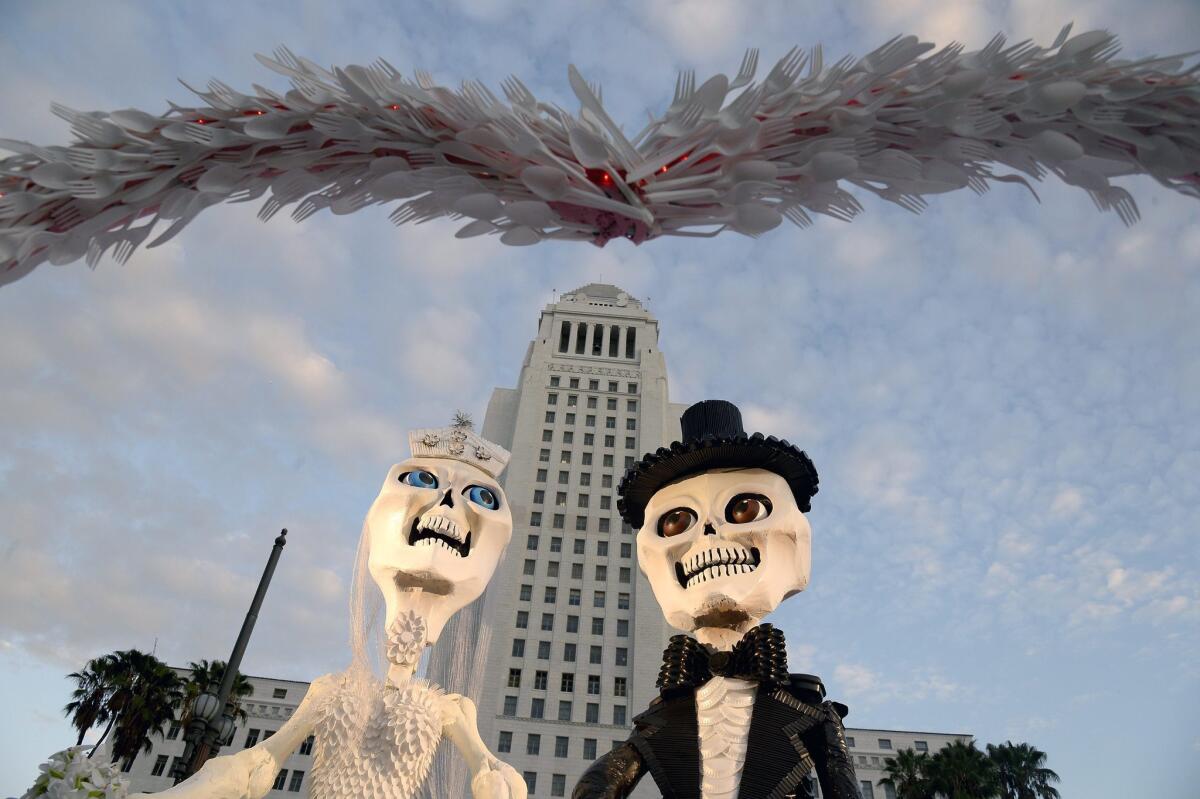Four fests honoring the dead (including Día de los Muertos) that are cooler than Halloween

A Dia de Los Muertos (Day of the Dead) altar of a wedding couple by Marcus Politz is displayed in Grand Park, across from City Hall, in downtown Los Angeles on Sunday. More than 40 altars by 30 Southern California artists are on display to celebrate the Day of the Dead, celebrated Nov. 1.
Sure, you know about Halloween, or All Hallows Eve, when kids beg for and usually get (unless you wish for your house to be egged) candy.
A boy plays in a cemetery during celebrations of All Saints' Day in the northern Spanish Basque city of Bilbao. (Rafa Rivas / AFP/Getty Images)
It’s tied up with the Christian observances of All Saints' Day (Nov. 1 in Western churches, on which saints are remembered) and All Souls' Day (Nov. 2, on which the departed are prayed for).
It has its roots in Samhain, a Celtic festival that wasn’t exactly fun and games. The gods, now visible to humans, inflicted themselves on the hapless mortals, creating an aura of fear and danger.
What the comforting, not creepy, Día de los Muertos can teach us
Not exactly the lighthearted fun of Halloween. Samhain is still celebrated today, although, the website Circle Sanctuary notes, usually in private.
But there are commemorations of the dead that aren’t all about the scary supernatural. They often involve visiting with those who have gone before us, perhaps catering to them (or appeasing them).
Here are some of them.
1. Día de Los Muertos
Día de los Muertos, Day of the Dead, celebrated widely in Mexico, other parts of Latin America and in many U.S. cities, including Los Angeles and San Francisco, is a family reunion of sorts.
Even Britain is getting into the act, this year with Days of the Dead at the British Museum, which it describes as “a free festival of art, performance, storytelling and talks to celebrate the Mexican tradition.”
The loved ones of the deceased gather to party; the official day this year is Sunday. They bring food and beverages to grave sites, where altars, or ofrendas, are created and adorned with marigolds.
You’ll often see calacas, the skeletal figures (Catrina is the best known) that are supposed to persuade those in this world that the next world is happy.
You’ll also see calaveras, the skull, often made of sugar, and pan de muerto, bread of the dead, a sweet treat that is eaten and offered.
The celebration aims to take the fear out of death so that those left behind understand that this death is just a transition.
2. Obon
Sometimes written O-bon, this festival is sometimes known as Japan’s Day of the Dead. It’s usually held around Aug. 15.
Relatives of the deceased may travel back to their home cities to gather with family and friends as they await the return of the spirits of their ancestors.
3. Hungry Ghost Month and Festival
We often speak of ghosts at this time of year, but rarely are their appetites part of the conversation. Not so with the Hungry Ghost Month and Festival, celebrated by Buddhists and Taoists, often in the larger cities of China (and in Southern California’s Chinese communities).
The festival is in the seventh lunar month (July or August by Western standards) and can last a month.
On the first day of the month of Hungry Ghost, the gates of hell are opened, and out come the ghosts. Food and drink are offered to appease these nettlesome visitors.
Fake paper money (called “hell money” or “hell notes”) may be burned as a way of providing for the ghosts. Prayers are said as well.
On the last day of the month, the ghosts depart and go back behind the gates of hell, not unlike houseguests who have overstayed their welcome.
4. Pchum Ben
In Cambodia, Pchum Ben is part of the Khmer religious calendar, usually occurring in September or October and lasting 15 days.
Like the other festivals, this one also involves offerings of food to the dead as a show of respect for deceased ancestors.
Like the hungry ghosts, the spirits of Phcum Ben are said to be soothed by these offerings, which are often taken to a pagdoa and offered by monks. In return a blessing is sometimes bestowed on the giver.
Like many holidays, Pchum Ben has a way of bringing people together for the shared experience, which becomes a common vocabulary for society.
Happy Halloween.
ALSO
The 10 creepiest Halloween haunts in the U.S.: Where to scare yourself silly
That glass bridge in China that scared the socks off visitors? It cracked
Americans love to visit London. Here are 6 reasons to go soon
Sign up for The Wild
We’ll help you find the best places to hike, bike and run, as well as the perfect silent spots for meditation and yoga.
You may occasionally receive promotional content from the Los Angeles Times.




